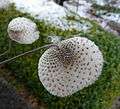Anemone hupehensis
| Anemone hupehensis | |
|---|---|
 | |
| Japanese anemones have yellow stamens and white petals. | |
| Scientific classification | |
| Kingdom: | Plantae |
| (unranked): | Angiosperms |
| (unranked): | Eudicots |
| Order: | Ranunculales |
| Family: | Ranunculaceae |
| Genus: | Anemone |
| Species: | A. hupehensis |
| Binomial name | |
| Anemone hupehensis (Lemoine) Lemoine | |
| Type | Flower |
|---|---|
| Light | Partial shade |
| Water | Moderate to large amount |
| Soil | Acidic soil |
| Hardiness | USDA Zone 4a to 8 |
| Bloom Period | White, pink, or purple color, late summer to early fall |
| Propagation | Root cutting[1] |
Anemone hupehensis, Anemone hupehensis var. japonica, and Anemone × hybrida (commonly known as the Chinese anemone or Japanese anemone, thimbleweed, or windflower) are species of flowering herbaceous perennials in the Ranunculaceae family.
Anemone comes from Greek, and it means “the wind’s daughter”. It is derived from anemos, the word for wind, and the suffix -one, which indicates a female offspring or daughter.[2]
Anemone × hybrida Paxton is a hybrid of Anemone hupehensis var. japonica and Anemone vitifolia.[3] It should not be confused with Anemone hybrida Miq. ex Pritz., a synonym of Anemone halleri All.
Description
Height is 3–4 ft (1–1 m). Leaves have three leaflets.
Flowers are 40–60 mm (1.6–2.4 in) across, with 5-6 (or up to 20 in double forms) sculpted pink or white sepals and prominent yellow stamens, blooming from midsummer to autumn.
Cultivation
These plants thrive best in shady areas and under protection of larger plants, and in all but the hottest and the driest conditions in the United States.[4] They are especially sensitive to drought or overwatering.[5] They can be invasive or weedy in some areas,[6] throwing out suckers from the fibrous rootstock, to rapidly colonise an area. Once established they can be extremely difficult to eradicate.[7] On the other hand, they can take some time to become established.[8]
Cultivars
The following cultivars have gained the Royal Horticultural Society's Award of Garden Merit:
History
A. hupehensis is native to central China, though it has been naturalised in Japan for hundreds of years.
The species was first named and described in Flora Japonica (1784), by Carl Thunberg. Thunberg had collected dried specimens while working as a doctor for the Dutch East Indies Company.[5] In 1844, Robert Fortune brought the plant to England from China, where he found it often planted about graves.[15]
Cultural Significance and Meanings[2]
The anemone has several different meanings depending on the culture and context in which the flower is being used.
Several of the Western meanings of anemone flowers pertain to the Greek Mythology of the origin of the anemone flower featuring Adonis and Aphrodite. Aphrodite kept Adonis as a lover, and in their jealousy, the other Greek gods murdered Adonis. After his death, Aphrodite wept over his grave in mourning, and her tears for her fallen love grew into Anemone flowers. This origin story lends itself to the Classical dual meanings of the arrival of spring breezes and the death of a loved one.
In the Victorian language of flowers, the anemone represented a forsaken love of any kind, while European peasants carried them to ward off pests and disease as well as bad luck.
In Eastern cultures, the meanings are very different. In Chinese and Egyptian cultures, it was considered a symbol of illness due to its coloring. It is also a symbol of bad luck to many Eastern cultures, and because of its origins, the Japanese Anemone tends to mean ill tidings.
Gallery
-

Seeds
-

Flower and buds in a private garden
References
- ↑ "Anemone hupehensis/Anemone japonica". Rob's Plants. Retrieved 7 January 2010.
- 1 2 "The Anemone Flower: Its Meanings & Symbolism". 11/26/16. Check date values in:
|date=(help) - ↑ Learn2Grow: Anemone × hybrida 'Pamina'
- ↑ "Anemones". plantideas.com. Archived from the original on 23 December 2009. Retrieved 2010-01-07.
- 1 2 Klingaman, Gerald (13 October 2006). "Plant of the Week Japanese anemone Latin: Anemone x hybrida". University of Arkansas Division of Agriculture. Retrieved 2010-01-07.
- ↑ "Anemone hupehensis var. japonica 'Bressingham Glow' (Japanese anemone)". The Taunton Press. Archived from the original on 3 January 2010. Retrieved 2010-01-07.
- ↑ RHS A-Z encyclopedia of garden plants. United Kingdom: Dorling Kindersley. 2008. p. 1136. ISBN 1405332964.
- ↑ Feather, Judy (5 January 2010). "Japanese Anemone: Fall Color in the Garden". CSU/Denver County Extension Master Gardener. Retrieved 2010-01-08.
- ↑ "RHS Plant Selector - Anemone hupehensis 'Bowles's Pink'". Retrieved 25 May 2013.
- ↑ "RHS Plant Selector - Anemone hupehensis 'Hadspen Abundance'". Retrieved 25 May 2013.
- ↑ "RHS Plant Selector - Anemone x hybrida 'Honorine Jobert'". Retrieved 25 May 2013.
- ↑ "RHS Plant Selector - Anemone x hybrida 'Konigin Charlotte'". Retrieved 25 May 2013.
- ↑ "RHS Plant Selector - Anemone hupehensis var. japonica 'Pamina'". Retrieved 25 May 2013.
- ↑ "RHS Plant Selector - Anemone x hybrida 'September Charm'". Retrieved 25 May 2013.
- ↑ "Anemone hupehensis 'Kriemhilde'". Paghat the Ratgirl. Retrieved 2010-01-06.
External links
| Wikimedia Commons has media related to Anemone hupehensis. |
| Wikispecies has information related to: Anemone hupehensis |